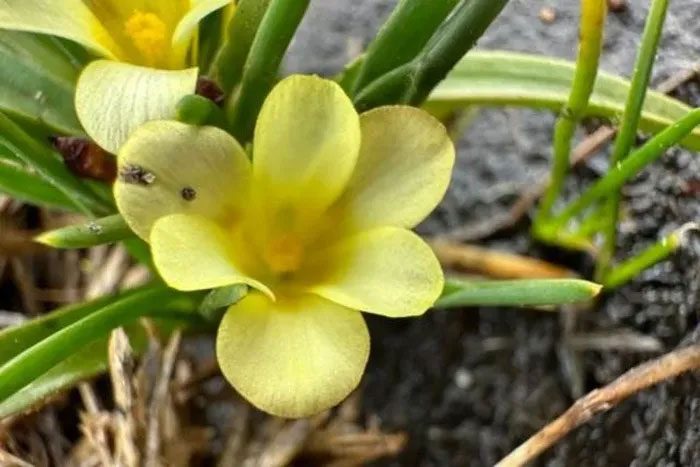Flower species thought extinct for 40 years suddenly grows on the road
A conservation manager made the discovery of a lifetime when he took a photo of what he thought was a common fynbos, a flower in the genus Moraea.
According to the nonprofit NWSMA, the flower is actually Moraea minima , also known as the Mini Galaxy flower, which was last seen more than 40 years ago and was thought to be extinct.

Moraea minima, a plant species thought to be extinct discovered in South Africa.
According to the World Wildlife Fund, species are going extinct in modern times at a rate 1,000 to 10,000 times faster than the natural rate, and humans are the main cause.
The International Union for Conservation of Nature (IUCN) lists more than 40,000 species as threatened, with more than 9,000 considered critically endangered. The Mini Galaxy was feared to be extinct until Eugéne Hahndiek, a conservation manager with the NWSMA, stumbled upon the flower growing in the middle of a road in Africa.
At the time, Hahndiek didn't know he had rediscovered a flower that scientists had long sought. He posted the photo to iNaturalist, an app used by scientists. The photo caught the attention of scientist John Manning.
Manning recognized the flower as a Mini Galaxy and notified the Conservation of Rare and Endangered Wildflowers (CREW) about the photo.
In July 2023, a CREW team searched for the flower at this location in hopes of finding it and studying it. Unfortunately, they were unsuccessful. However, when they returned in August 2023, they found the flower in a new location.
"It seems that this particular flower is hard to find because it's quite finicky. What we found is that it only blooms in the spring for a few hours after it rains. Then the flowers disappear, until the next rains come . The other challenge is that these plants often grow in somewhat precarious places, such as on the side of the road or in the middle of the road . That's why we need to know where they are, in order to plan for their protection ," Hahneick said.
The flowers bloom in August, Hahndiek told Newsweek. The rest of the year, the flowers are difficult to identify. Now that the NWSMA knows where the flowers are, they plan to incorporate the species into their conservation efforts by eradicating invasive species and creating a wildfire management plan.
'We have been educating landowners about the species and where they occur, to make sure they know how special they are ,' Hahndiek said.
The discovery comes after the Endangered Species Act officially removed 21 species from the list as extinct. Several other species thought to be extinct have also been rediscovered, including the Ilex sapiiformis tree in Brazil and a whitefish in the North Sea.
Since beginning the search for the Mini Galaxy flower, the CREW and NWSMA teams have identified two populations of this flower, which was last officially seen in 1981.
- The unmanned drone suddenly found the flower in Hawaii to be extinct
- Discovered wild flowers thought extinct 40 years ago in Ecuador
- Discovered frog species extinct 20 years ago
- Species of extinct animals suddenly appeared in Thanh Hoa
- Reappearing extinct salmon species 70 years ago
- Found monkey thought extinct
- Extinct species lurking in Canada, living for another 5,000 years no one knows?
- Rediscover 3 extinct amphibian species
- Found a species of magnolia that has been lost for nearly 100 years in Haiti
- Discovering the 'love path' where 5 species of humans mate in deformities
- Guam island birds back after 40 years of extinction
- Development technology revives extinct species?
 Why do potatoes have eyes?
Why do potatoes have eyes? 'Tragedy' the world's largest carnivorous life: Death becomes ... public toilet
'Tragedy' the world's largest carnivorous life: Death becomes ... public toilet Tomatoes were once considered 'poisonous' for 200 years
Tomatoes were once considered 'poisonous' for 200 years Detecting microscopic parasites on human face
Detecting microscopic parasites on human face